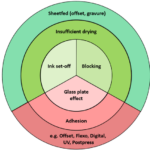Ink set-off: sheet-fed printing
In the delivery pile, the color on the printed sheets is usually not completely dry. The freshly printed ink is transferred from the surface of one printed sheet to the back of another sheet above in the stack.
To enable the sheets to dry, KSL anti set-off powder is sprayed between the sheets as spacer. This allows air and oxygen to get to the ink and enable evaporation and oxidative drying. Especially for coated paper, where drying does not occur via absorption by the substrate, the use of KSL anti set-off powders is indispensable.
Positive side effect:
The powdering increases the slidability of the sheets and promotes an even, smooth-edged pile formation. This is crucial for print finishing.

